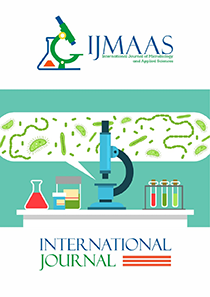Bacteriological Quality, Antibiotic Susceptibility of Isolated Bacteria and Proximate Composition of Different Brands of Packaged Fruit Juice
Vol 2, Issue 2, 2023
KEYWORDS
Fruit Juice, bacteriological quality, proximate composition, Bacillus, Lysinibacillus, antibiotic resistance
Abstract
Juices are drinks expressed from the edible part of fruits or any concentrates of such fruits. Fruit juice makes a good medium for microbial growth. This study was conducted to determine the bacterial load, antibiotic susceptibility of isolated bacteria, and the proximate composition of packaged fruit juices sold in Port Harcourt, Nigeria. A total of forty (40) samples of packaged fruit juice of four (4) different brands were analyzed using the Analytical Observational Cohort design. Results showed that, mean value of total heterotrophic bacterial count was highest in Ribena 1.88±1.04 x 103CFU/ml, followed by Capri-sun 0.77±0.67 x 103CFU/ml, then Chi-exotic 0.57±0.74 x 103CFU/ml, while Happy-hour recorded the least value of 0.49±0.64 x 103CFU/ml. There was no statistically significant difference in the total heterotrophic bacterial counts. Isolated and identifies bacteria were ten species of Bacillus sensitive to Gentamicin, Erythromycin, Ciprofloxacin and Chloramphenicol, but resistant to Tetracyclin, Trimethoprim, penicillin and Cefoxitin; three Paenibacillus sensitive to Gentamicin, Erythromycin and Tetracyclin, but resistant to Ciprofloxacin, Trimethoprim, Chloramphenicol, Penicillin and Cefoxitin; and two Lysinibacillus species that were sensitive to Gentamicin, Erythromycin and Cefoxitin, but resistant to Tetracyclin, Ciprofloxacin, Trimethoprim, Chloramphenicol and Penicillin. Multiple antibiotic resistance (MAR) index was greater than 0.2. The ash content of Capri-sun, Chi-exotic, Happy-hour and Ribena were 0.04±0.00, 0.12±0.00, 0.04±0.00 and 0.04±0.00% respectively; Crude protein was 0.22±0.00, 0.19±0.00, 0.08±0.00 and 0.08±0.00% respectively; fat content was 0.10±0.00, 0.11±0.01, 0.10±0.00 and 0.08±0.00 % respectively, while carbohydrate was 12.34±0.23, 12.72±0.04, 12.56±0.06 and 12.43±0.06%, respectively. All brands of fruit juices met Gulf standard for microbial load. However, spore bearing Bacillus found in this study is of public health concern. There is therefore the need for thorough quality control measures to control the presence of undesired bacteria in fruit juices.
Current: Vol 3, Issue 1, 2024

Call for papers
The International Journal of Microbiology and Applied Sciences warmly welcome your valuable articles for publication.
